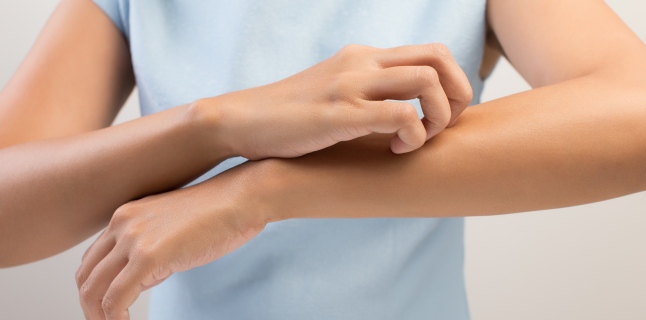Urticaria - a disease that should not be overlooked

The lesions can be spread over all skin with the appearance of \. The color of the urticaria papules is pale pink, the lesions are generally pruritic (itch), and the extended forms can give a state of agitation, headaches, general malaise. Drugs: Immune system hikes produce antibiotics (penicillins), sulfamides, quinolones, nonsteroidal anti-inflammatory drugs, sedatives, tranquilizers, barbiturates, laxatives, diuretics, conversion enzyme inhibitors,. Hives with non-immunological mechanisms may be produced by the following drugs - atropine, papaverine, morphine, codeine. The food factor: meat, sausages, fats, crustaceans, fish, shellfish, eggs, berries such as hazelnuts and seeds, nuts, red hearts and seeds (strawberries and blueberries) . Infectious Factor: chronic, tonsillitis, suppurative otitis, dental focalities, cholecystitis, lambliaza, chronic pyelonephritis, chronic cystitis, vulvovaginitis.
Internal diseases - collagenoses, haemopathies (lymphomas, macroglobulinemia, polycythemia), acute articular rheumatism, visceral cancers. Physical factors: heat, pressure, water, vibrations can produce particular forms of hives, called physical hurts. Contact factors: potentially allergenic substances: pollens, dust, molds. Inhaler or pneumoallergen allergens - house dust, flakes, molds, animal hair fragments. - especially after bee stings, wasps to sensitized people.
Genetic factors: are more involved in the occurrence of familial angioedema (hereditary). Psychiatric factors: Associate in the mechanism of maintenance of a hurricane, patients being very agitated at the smallest signs of eruption or recognizing the appearance of lesions due to conflicting or stressful states. 1. After the production mechanism there are immunological urticaria (triggered by food or drugs through immunological reactions); . 2.
After the type of lesions, urticaria can be classified as: gingival urticaria, dyskine urticaria, ringing urticaria, geographic centrifugal urticaria, rubella urticaria, white urticaria, bullous urticaria, haemorrhagic urticaria, pigmentary urticaria. 3. After the duration, urticaria may be acute, with sudden onset and rapid disappearance of the lesions within a few hours or days; . • analyzes for the balance of the general state of the organism: VSH, blood count, leukocyte and eosinophil count, glycemia, kidney, liver, C reactive protein, • analyzes to identify outbreaks of infection: pharyngeal exudate, nasal exudate, uroculture, . Individuals diagnosed with urticaria are advised to have a hygienic-dietetic digestive diet regimen with a diet of exclusion and reintroduction of allegedly incriminated foods.
It will consist of a restriction on the consumption of certain foods, especially meat, fats, coffee, dairy products, eggs, fish, seeds, with the gradual introduction of food, a new food in 2-3 days. Drug treatment is made with antihistamines, and in some cases also sedative-tranquillizers or certain types of antidepressants. They can especially associate with extended rash, when the patient is agitated and the lesions are very pruritic. Also, the infectious factor or other etiological factor must be removed (moldinisation, tonsil removal, treatment etc. .
). Systemic corticotherapy is associated with vasculitis urticaria. Local treatment is recommended in situations with extensive urticarial eruptions, and can be done with soothing mixtures, dermatocorticoids in creams and gels, antihistamines. .
Source : sfatulmedicului.ro
Views : 3125
Popular Article
- (photo) Nude becomes art.
Posted: 2018-03-17, 9809 views.
- The harmful effects of air conditioning on the skin
Posted: 2017-06-08, 8517 views.
- 3 causes of dyed hair discoloration
Posted: 2017-06-15, 8401 views.
- Why early puberty occurs in girls: symptoms, favors, diagnosis and treatment
Posted: 2017-10-24, 8241 views.
- Good or bad skin treatments in the hot season
Posted: 2017-06-07, 7974 views.
Recommendations
- (photo) Nude becomes art.
Posted: 2018-03-17, 9809 views.
- The harmful effects of air conditioning on the skin
Posted: 2017-06-08, 8517 views.
- 3 causes of dyed hair discoloration
Posted: 2017-06-15, 8401 views.
- Good or bad skin treatments in the hot season
Posted: 2017-06-07, 7974 views.
- Risks of practicing sports on hot days
Posted: 2017-06-12, 7547 views.
 4 effective ingredients in the fight against acne.
4 effective ingredients in the fight against acne. How to get rid of hiccups fast
How to get rid of hiccups fast The wheat bran diet: the secret of lost pounds as if by magic
The wheat bran diet: the secret of lost pounds as if by magic The recipe that will sweeten your soul this weekend!
The recipe that will sweeten your soul this weekend!  Is it dangerous or not to refreeze meat after thawing it?
Is it dangerous or not to refreeze meat after thawing it?  The unusual sign of diabetes indicated by saliva.
The unusual sign of diabetes indicated by saliva. What to drink to boost your immune system.
What to drink to boost your immune system. 10 foods that help you never age.
10 foods that help you never age. What actually happens in your body if you drink a cup of coffee for breakfast
What actually happens in your body if you drink a cup of coffee for breakfast 5 surprising benefits of chia seeds
5 surprising benefits of chia seeds